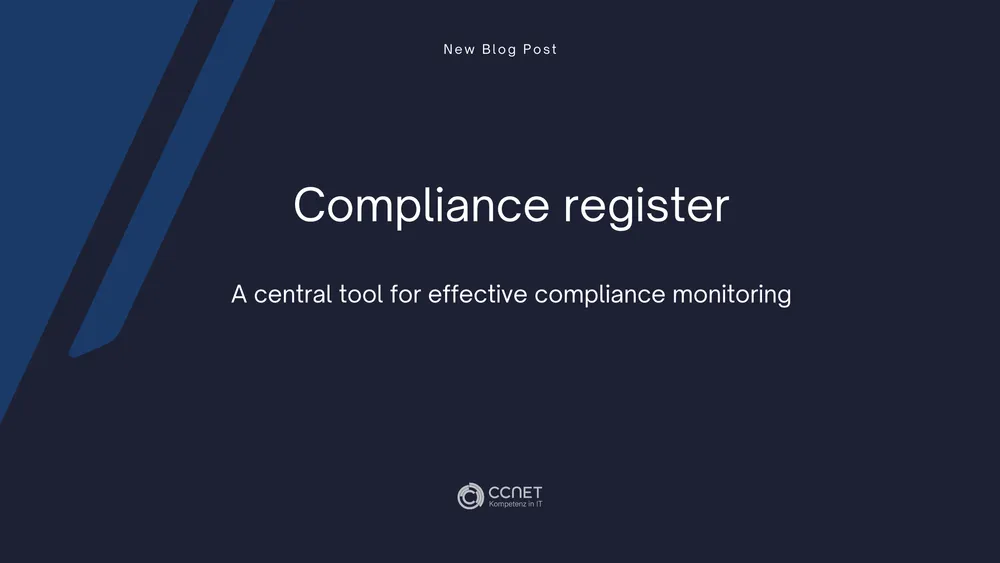
CCNet
Dec 9, 2024 • 3 min read

How Your Cybersecurity Team Protects Your IT in Compliance with NIS2 Requirements
A strong cybersecurity team is at the core of a successful cybersecurity strategy, especially concerning the requirements of the NIS2 Directive. But what exactly does a company need to be fully protected – and more importantly: How can this protection be implemented?
Further information can be found here: IT-Consultation
In this post, we will show you which specific measures are required to build an effective cybersecurity team, and how this team works to ensure the protection of your IT infrastructure. The right mix of technical expertise, proactive threat detection, and continuous adaptation of security measures ensures that your company is equipped against the myriad threats of the digital world.
What You Need: A Specialized Cybersecurity Team
A strong cybersecurity team consists of a group of experts with different specializations. Each expert brings unique skills and responsibilities that together enable comprehensive defense against cyber threats.
But how does the collaboration of these experts work in practice?
How to Implement It: Structure and Task Allocation
1. Security Engineer: Effectively Implement Technical Safeguards
The Security Engineer is responsible for setting up and maintaining the fundamental security infrastructure – including firewalls, VPNs, and Intrusion Detection/Prevention Systems (IDS/IPS). But how can you ensure that these systems function optimally?
- Solution: The Security Engineer implements a multilayered security architecture based on the latest technologies. This allows your company to not only detect threats but actively prevent them. Regular maintenance and updates ensure that all systems are always up to date.
2. Threat Intelligence Analyst: Early Detection of Threats
A Threat Intelligence Analyst plays a key role in identifying cyberattacks early. But how exactly is this done?
- Solution: The analyst continuously gathers and analyzes threat data from various sources. By creating threat models, they can identify potential risks early on. Regular reports and recommendations to the Incident Response Team ensure that the entire company is immediately prepared for new threats.
3. Penetration Tester: Simulating Attacks to Strengthen Your Defense
A Penetration Tester checks your IT systems by simulating real cyberattacks. But how can vulnerabilities be effectively detected?
- Solution: Using specialized tools such as Metasploit or Nmap, the Penetration Tester conducts detailed tests specifically targeting weaknesses in your networks and systems. Once vulnerabilities are discovered, they work closely with the IT team to implement immediate measures to close these security gaps.
4. Cybersecurity Analyst: Continuous Monitoring of Your Systems
Constant monitoring of systems and networks is crucial for detecting attacks in real-time. But how does the Cybersecurity Analyst ensure that no threat goes unnoticed?
- Solution: The analyst uses a Security Information and Event Management (SIEM) system that continuously monitors all security-related events. Suspicious activities are immediately reported and analyzed in detail to take rapid and targeted countermeasures.
5. Malware Analyst: Defending Against Malware
A Malware Analyst examines all aspects of malware to understand its structure and develop effective countermeasures. How do they ensure that new malware is detected and neutralized immediately?
- Solution: Through reverse engineering, the Malware Analyst can analyze the functionality of malware in detail. The results of this analysis allow for the development of customized protection strategies that respond immediately to new threats.
6. Vulnerability Manager: Proactively Fixing Vulnerabilities
The Vulnerability Manager is responsible for vulnerability management and ensures that risks are immediately addressed. But how do they ensure that no vulnerability goes unnoticed?
- Solution: The Vulnerability Manager uses specialized tools to identify and assess vulnerabilities. Regular patch management processes and risk assessments guarantee that all security gaps are closed before they can be exploited.
What You Need: Coordination and Effective Communication
In addition to the technical implementation, collaboration and coordination between the various departments are crucial to the success of a cybersecurity team. But how does this collaboration work in practice?
How to Implement It: Collaboration Across the Company
-
Regular Vulnerability Scans and Penetration Tests: The team routinely conducts vulnerability scans and penetration tests to check the network for weaknesses. This provides the company with the assurance that it is continuously protected.
-
Communication of Threats and Security Incidents: Through close collaboration with the Incident Response Manager and other departments, threats and incidents are immediately identified and addressed. The exchange of important information between teams ensures that all parties are on the same page and can act quickly.
Conclusion: Achieving Comprehensive Protection Through Your Cybersecurity Team
With a well-organized and specialized cybersecurity team, you can secure every area of your IT while also meeting the requirements of the NIS2 Directive. This team not only ensures monitoring and prevention but also enables you to proactively respond to threats and fix vulnerabilities before they become a problem.
With clear structures, effective collaboration, and the targeted use of the latest security technologies, your company protects itself fully – staying one step ahead. Ensuring that your IT infrastructure is optimally secured and meets all compliance requirements is essential. Get in touch with us: our team of experts is ready to work with you to develop a comprehensive security strategy.


